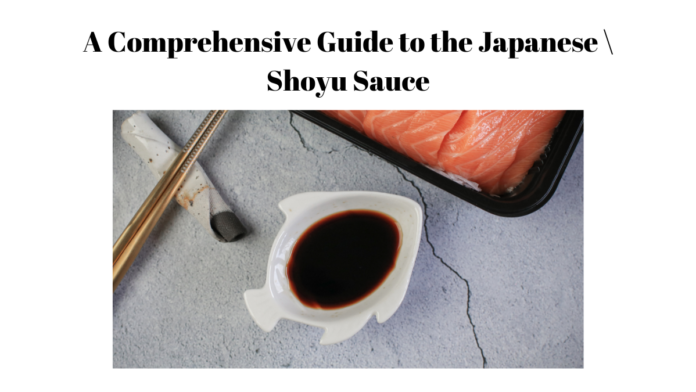Shoyu sauce means soy sauce, and it is traditional Japanese soy sauce with a different taste from Chinese soy sauce. The special taste of Japanese soy sauce is caused by the difference in the formulation of the recipe compared to the widely known Chinese-style soy sauce.
What is Shoyu?
Shoyu exclusively denotes Japanese-style soy sauces, primarily crafted from fermented soybeans and wheat in a balanced ratio of 1:1, accompanied by sea salt and water used in preservation. This basic recipe is the foundation for shoyu sauce.
Shoyu sauce production usually involves toasting the wheat, which adds to the complex flavour of the final product. Commercial manufacturers usually transform the recipe by adding ingredients like mirin, sweets, vinegar, etc.
Most shoyu recipes use Koji, a fungus used for saccharification in rice and barley, which is employed in processes such as alcohol production (sake) and soybean fermentation (miso paste). And sometimes in rare instances, different mold cultures are used.
Shoyu sauce generally has a standard of 50% soybeans and 50% wheat with a combination of water and sea salt, without further embellishments in most cases. Its unique tastes come from a fermentation process that lasts at least six months but can stretch for two years.
Distinguishing Shoyu from Regular Soy Sauce
Most modern people refer to soy sauce as just soy sauce in an everyday way. However, it is usually a Jìang You or Chinese-style soy sauce. This term is commonly used as a synonym without an explicit definition since it refers to the world’s most popular form of soy sauce.
Chinese-style soy sauce is created by mixing grains (most of the time wheat), fermented soybeans, and preservatives, very much like Japanese Shoyu sauce. However, there are several variations in the recipes.
The soybean-wheat ratio was not as guarded in Chinese-style soy sauce. These soy sauces often boast a more substantial soybean presence, with ratios typically fluctuating between 70/30 to 80/20. In Chinese-style soy sauces, normal wheat flour is widely used.
It is hydrolyzed soy protein or a chemical method that fastens the production process and helps to kill the price. Additionally, these sauces ferment for a much shorter period than that of Shoyu sauce. Although premium varieties may ferment for more than 1 year or from 5 to 8 months, Chinese soy sauce is fermented in weeks, they can only take few weeks or one month.
How is Shoyu sauce prepared?
Beginning the soy sauce production process entails soaking soybeans and wheat. Soybeans are then steaming, while wheat is toasted and ground before being mixed. When the main components are combined, the specific mould selected, usually Koji, is used to prepare for fermentation.
The combination of the soybean-wheat-mould association is then placed in isolation for several days, during which Koji mould grows and spreads over the surface of the mixture. The key factor in this fermentation process is the presence of this mould, which helps to break down various components in this mixture due to the presence of crucial enzymes. This breakdown process is assisted by the mould enzymes related to the lipids, proteins, starch, fatty acids, and cellulose matured.
After the Koji mould has grown, the mixture left to mature is mixed with sea salt water, giving an organic composition known as Moromi.
The fermentation of moromi is done in tanks for a minimum period of six months, which is the baseline for Shoyu sauce, although the procedure may go on for three years or more. The fermentation time directly correlates with the intensity and complexity of the final shoyu sauce taste.
After the maturation of the Moromi mix, it is covered in cloth and pressed to get crude soy sauce. The crude liquid is sterilized to remove dangerous bacteria, refined, and bottled for commerce.
Utilization of Shoyu Sauce
Shoyu sauce can be used as a spice or dip, mainly known as koikuchi. It is commonly used to enhance the taste of soup and stew bases, either intensifying the umami or making shoyu the centre of the dish. One of the most prominent is Shoyu ramen, an iconic noodle soup in which the broth loaded with the strong taste of shoyu is the main character.
It is a classic shoyu sauce produced by a premium grade that is considered an ideal individual dip, as it is used in restaurants with sushi and gyoza. Shoyu can be a primer for ponzu and teriyaki, which are very popular sauces.
Shoyu sauce is very famous in marinade blends and is quite convenient for eggs, fish, chicken, pork, etc. Koikuchi shoyu is a favourite among standalone marinade utilizations, while tamari and usukuchi sauces are also widely used. In particular, Usukuchi sauce works well with other marinade blends because it has a relatively strong taste that goes well with seasonings and other flavouring agents without being easily dominated.
Pickling has also become another frequently used ingredient of shoyu sauce. Shiro shoyu, said to be superior at preserving bright colours without change, has been recognized as a very appropriate soy sauce for pickling. Due to its mild character, shiro shoyu is a good seasoning for cooking seafood, especially shrimp and scallops.
Alternatives for Shoyu Sauce
Liquid aminos represent an alternative to shoyu sauce, a product obtained by hydrolysing soy protein into free amino acids in an acidic solution.
Therefore, liquid aminos have a more subtle and low-sodium taste than regular soy sauce. However, they possess detectable hints of sweetness, making them a good replacement for shoyu sauce.
Conclusion
This detailed guide unveils the intricacies of Japanese shoyu sauce, providing information regarding its production approaches, preparation and wide range of uses. Shoyu is evident in its precise mixture of soybeans and wheat, as well as the key role of the Koji mold in fermentation, which can be considered a very sophisticated soy sauce version. Shoyu is the essence of Japanese cuisine, whether it is used as a base for traditional dishes like shoyu ramen or as a marinade for different ingredients. Search for alternatives such as liquid aminos.
FAQs
Is shoyu soy sauce good?
The unmatched flavour of Japanese soy sauce, or shoyu, with its salty, umami-rich goodness, is something you have probably had with sushi, ramen, fried rice, stir-fries, and many other foods. It’s more than just the typical brand you know from your local supermarket’s international section.
How do you store shoyu?
Soy sauce is a light and temperature-sensitive product, similar to olive oil and vinegar, so it is better to store it in a cool, dark area when not opened. Soy sauce that is left open will be more likely to stay fresh and maintain its taste if it is placed in the fridge.
How long does soy sauce last?
Unopened soy sauce can last for up to three years if stored in a cool, dry place away from direct sunlight. Once opened, the shelf life of soy sauce can be reduced to several months, and it should be stored in the refrigerator to help preserve its flavour and quality.
What are the benefits of shoyu?
Scientists have recognized Shoyu’s high content of brown pigment, which delayed the occurrence of cancer, and its anti-oxidative capacity. Shoyu helps in the digestion of grains and contains several minerals at the same time.















